DQI
Data Quality Indicators (DQI) is a quantitative measure for the quality of data that is obtained from image recognition in a visit. DQI allows you to evaluate the quality of photos in scenes and the reliability of the data obtained from them.
DQI is formed for:
- individual photo — for example, sharpness or perspective;
- scenes — for example, check the statement that not all products of the target category in the store were photographed;
- visit — for example, if the value of one of the indicators is very different from the historical data.
View DQI
The DQI list is available in the results of the entire visit, each task of the visit, or each photo in a scene.
To view DQI open Visits and select a visit to view.
If the visit is not yet completed, correct the comments pointed out by the portal and check the results again.
- Visit
- Task
- Photo
The results of the visit show the entire DQI list, which is obtained from the results of the tasks.
Press DQI and view the list. To go to a photo with DQI, click on its name.
Only DQIs for the selected task is displayed in visit tasks.
- In the task block, expand the list and click on the task name.
- Scroll to the bottom of the issue and view the DQIs returned by the portal.
- Check that DQI mapping is enabled for display on photo. If not, click Show and set the DQI flag.
- View the photo in the scene. Photos that do not match the portal's quality settings will display a DQI warning.
- Click on the indicator on the photo and read the information.
Types of DQI Alerts
The DQI warning states:
- Severity — warning type;
- Associated — which part of the visit is related to the warning;
- DQI type — a type of error or warning;
- Value — DQI indicator value;
- Treshold — value below or above which (depending on the type of DQI) the indicator value should not be.
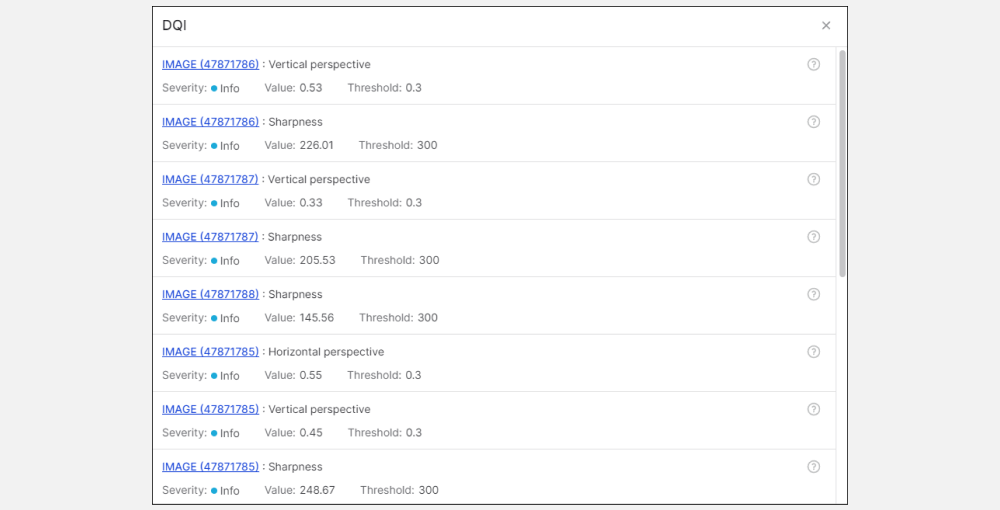
Severity
- CRITICAL — critical alert, such as photo fraud.
- WARNING — warning, such as wrong category or perspective.
- INFORMATION — remark, for example, a very blurry photo.
- DISABLED — indicator is disabled and not calculated.
Associated
- IMAGE — single photo on a visit. Indicators are calculated after photo recognition.
- SCENE — visit scene. Metrics are calculated before updating the metrics for the scene.
- VISIT — visit, indicators are calculated after the visit is closed.
All indicators are calculated each time anew: old indicators associated with the specified object are deleted, and new ones are saved to the database.
Groups and DQI visibility
DQI can be grouped and assigned to a specific task, as well as configured for visibility on the portal and IC application (and the ability to disable DQI altogether). This is controlled by settings within DQI. Only 1 DQI group can be linked to a single task. When creating a new DQI, it will not have a default group, and the visibility of such a DQI will be default for both: the portal and the IC application.
How it works:
- If the task is not linked to a DQI group - there are no restrictions;
- If the task is linked to a DQI group:
- Only DQI from the group is calculated.
- The thresholds specified for the group (severity, associated, visibility) are applied.
- Records about DQI are created only if DQI was in the group AND the threshold was exceeded (and there is visibility)
DQI type
Photo
The type of DQI that is output for the visit photo.
Sharpness
A quantitative measure of the sharpness of the photo.
How does it work:
The photo analyzes the sharpness indicator. If the score is below the threshold, then the system generates a DQI. By default, Threshold=300.

Horizontal perspective
The angle is a measure for horizontal lines.
How does it work:
The system analyzes the app_perspective_angle_hor indicator in the photo. If the score is below the threshold, then the system generates a DQI. Default Threshold=0.3.
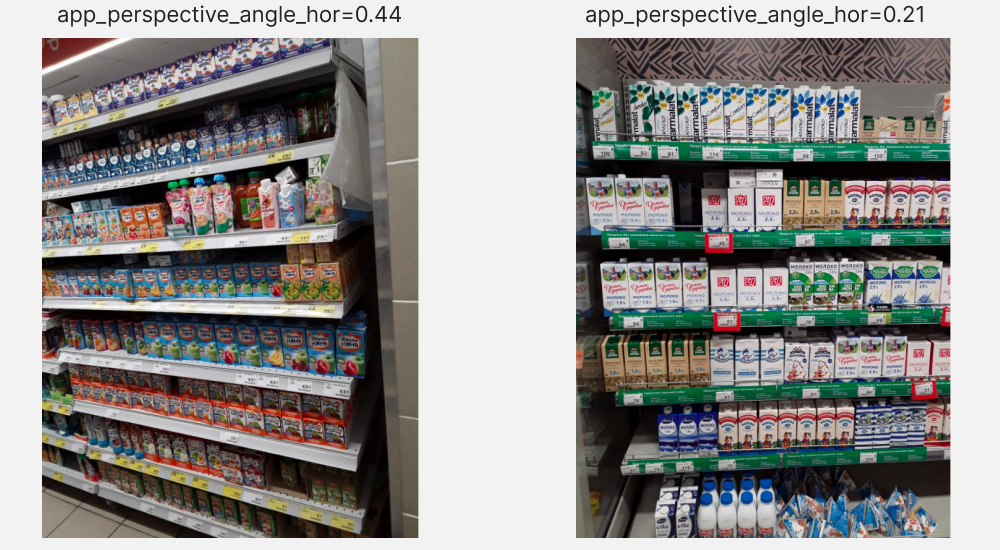
Vertical perspective
The angle is a measure for vertical lines.
How does it work:
The system analyzes the app_perspective_angle_vert indicator in the photo. If the score is below the threshold, then the system generates a DQI. Default Threshold=0.3.
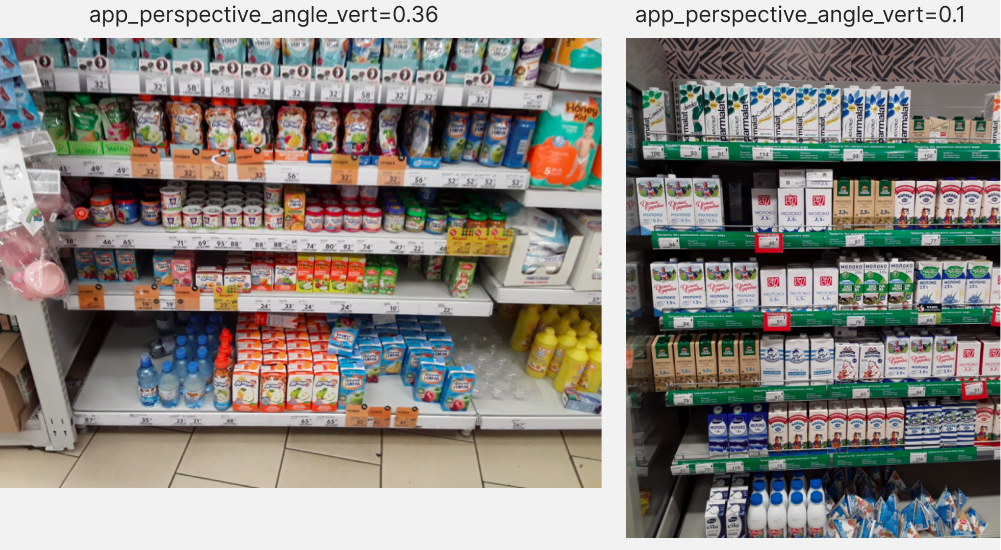
Horizontal camera angle
An indicator that reflects the excess of the shooting angle horizontally.
How does it work:
After taking a photo, the system analyzes the horizontal angle of the photo and records the result in the dqi_camera_angle_horizontal index. If the score is greater the threshold, then the system generates a DQI. Default Threshold=5.0.

Vertical camera angle
An indicator that reflects the excess of the shooting angle vertically.
How does it work:
After taking a photo, the system analyzes the vertical angle of the photo and records the result in the dqi_camera_angle_vertical index. If the score is greater the threshold, then the system generates a DQI. Default Threshold=5.0.
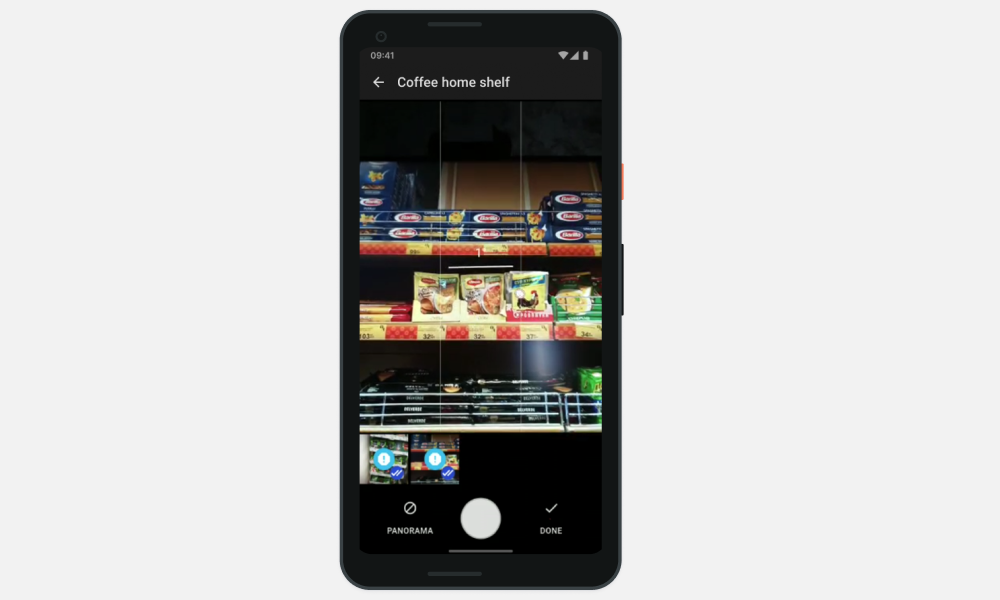
Small-scale or large-scale photo
The system uses a scale when defining a key figure. This is the average height of the annotation to the height of the photo, or scale in millimeters per pixel as estimated by the size correction algorithm.
How does it work:
The system takes all the annotations for a particular photo, calculates the average height, and divides it by the height of the photo. The result is written to the scale_coef.
The system generates a DQI if the value of scale_coef is:
- more than the upper threshold value. Default Threshold=0.25;
- less than the lower threshold value. Default Threshold=0.05.
Photo without products
A metric for a photo that has no products or all products classified as "unknown SKU".
How does it work:
The system takes all SKUs recognized in the photo (except for "unknown SKU") and records their number in the sku_count indicator. If the score is below or equal to the threshold, the system generates a DQI with the value sku_count.
Default Threshold=0.
Fraud Screen
Created for photos of products that are taken from any device with a screen - phone, computer, or tablet.
How does it work:
A neural network classifier is used to determine the fraud. The system analyzes the information from the photo and compares it with the parameters of the model. If the value obtained from the photo is higher the threshold, the system determines the type of fraud and creates a DQI. By default, Threshold=0.9.
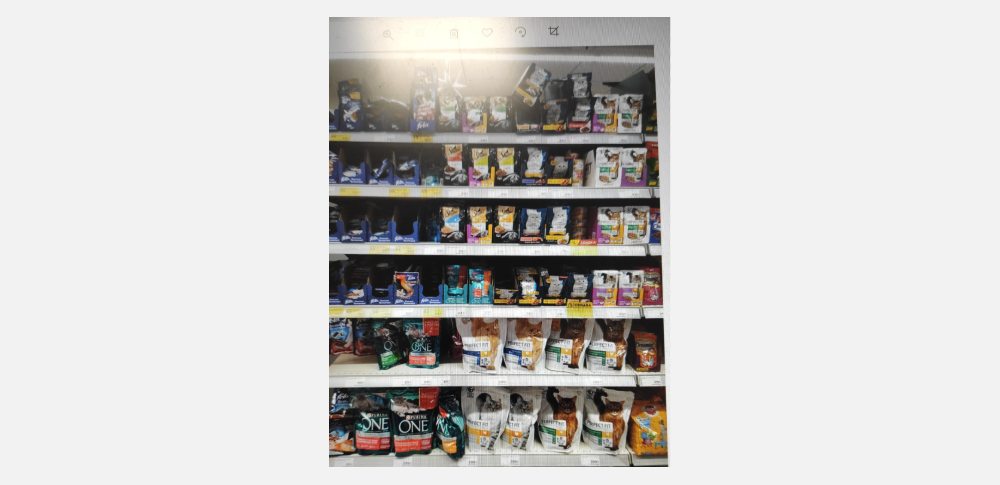
Fraud Paper
Created for photos of products that are made from paper: magazines, catalogs, planograms, and so on.
How does it work:
A neural network classifier is used to determine the fraud. The system analyzes the information from the photo and compares it with the parameters of the model. If the value obtained from the photo is higher the threshold, the system determines the type of fraud and creates a DQI. By default, Threshold=0.9.
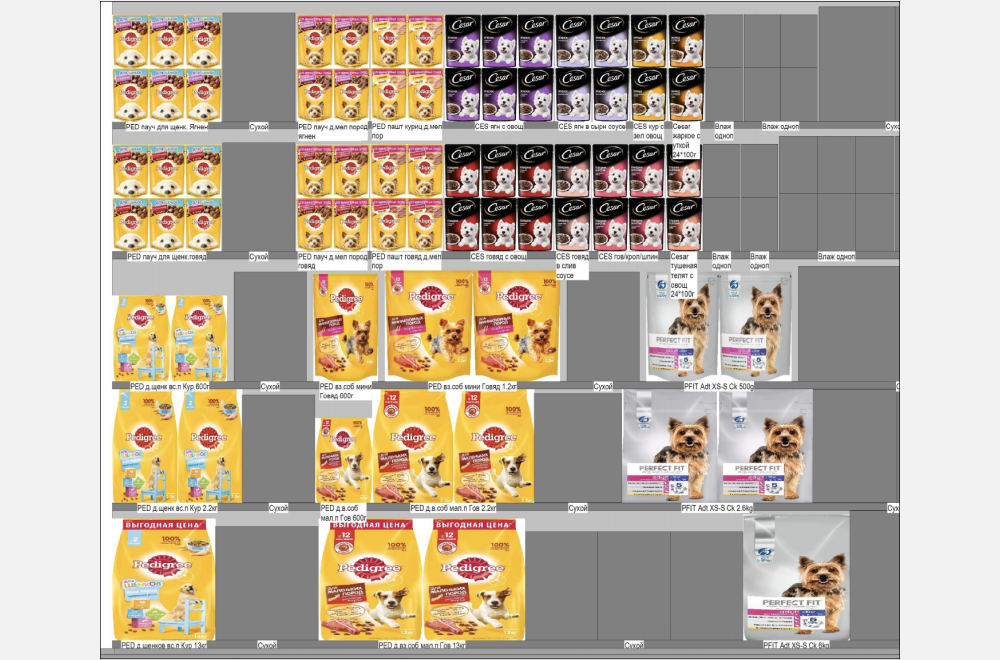
Fraud Place
DQI is created if in the photo:
- there are products, but they are not in the store. For example, a photo of a product in a car or on the street;
- there are objects, but they are without goods. Like an empty refrigerator.
How does it work:
A neural network classifier is used to determine the fraud. The system analyzes the information from the photo and compares it with the parameters of the model. If the value obtained from the photo is higher the threshold, the system determines the type of fraud and creates a DQI. By default, Threshold=0.9.
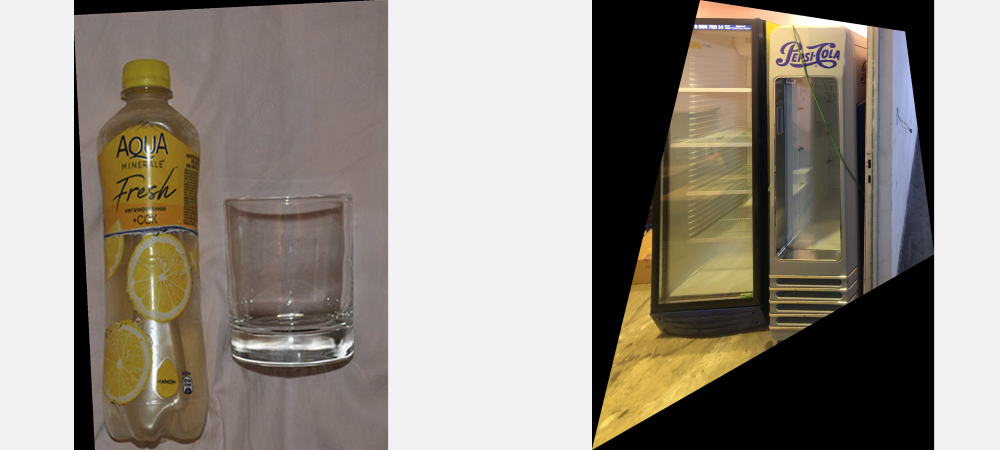
Scene
Wrong category
Product metrics for the scene, which reflect the number of faces in the target category to the total number of faces.
How does it work:
The indicator is calculated as the % of faces in the target categories for the scene with the total number of recognized faces. Target categories are set in the visit task settings.
Category not fully shot
An index indicating that the photos contain annotations of the target product category that are not captured in their entirety, which means it can be assumed that there may be a continuation of this display beyond the borders of the photo.
How it works:
After pasting, annotations that are adjacent to the edge of the pasting and are not in the whole frame are counted. By default, the DQI trigger threshold is 1, meaning that any target category annotation that is cropped by the frame will trigger warnings. Target product categories for a task are set when creating and customizing the task.

Visit
Too far from the store during the visit
Appears if the employee was far from the store during the visit.
How does it work:
During the visit, the system determines:
store_distance_m- device distance from the store;accuracy_m- accuracy.
If during the visit there was at least one record where the sum of the indicators is greater than the threshold value, then the system creates a DQI. The DQI value specifies the maximum value of the sum of store_distance_m and accuracy_m.
Default Threshold=500, measured in meters.
Long time without photos during the visit
The system keeps track of timestamps for photos, and calculates long periods of inactivity during the visit.
How does it work:
The system takes all photos for non-deleted visits, sorts them by date of creation, and checks the delta indicator - the period between the time the photo was created.
If the value is greater than the threshold value, then the system generates a DQI. The DQI value records the longest period during which no photos were taken.
Default Threshold=60, measured in minutes.
Very short/long visit
The system analyzes the duration of the visit. The system sets a time limit for the visit; short visits are considered suspicious.
How does it work:
The system determines the time from the beginning to the end of the visit according to the application clock and records it in the delta indicator. Then, this indicator is compared with the threshold value. If the value is above or below the threshold, create a DQI and write the delta value into it.
DQI has generated if the indicator value:
- below the threshold value. Default Threshold=5;
- above the threshold value. Default Threshold=720.
Measured in minutes.
Short time interval between visits to different stores
The system determines the time limit between consecutive visits or the speed of movement between stores. To do this, the system divides distance between stores on the map by time between visits to them. Too high speed can signal fake GPS.
How does it work:
- The system takes the distance between the store with the current visit and the store where the previous visit was made.
- The time between the end of the previous visit and the start of the current application according to the clock is determined.
- The system calculates the travel speed.
If the movement speed is greater than the threshold, then a DQI is generated. Its value is the speed of movement.
By default, for short visits Threshold= 60, measured in km/h.
The amount of photos is too low compared to previous visits (DQI_VISIT_DIFFERS_FROM_PREVIOUS)
The system determines how different the indicator is from previous visits to the same store.
How does it work:
The system takes the number of photos in the current visit and divides it by the average number of photos of the last 10 visits (the current session is not taken into account). If the received value is below the threshold, a DQI is generated.
Default Threshold=50, measured in %.
If you have any questions or problems, contact support.
DETECTED FAKE GPS
Fixing fake coordinates on the device.
How does it work:
Any modification of the coordinate system with the value swap during the visit triggers Fake GPS. For example, VALUE swap can be performed by third-party applications (GPS Emulator, Mock Locations, and others).